Full text
PDF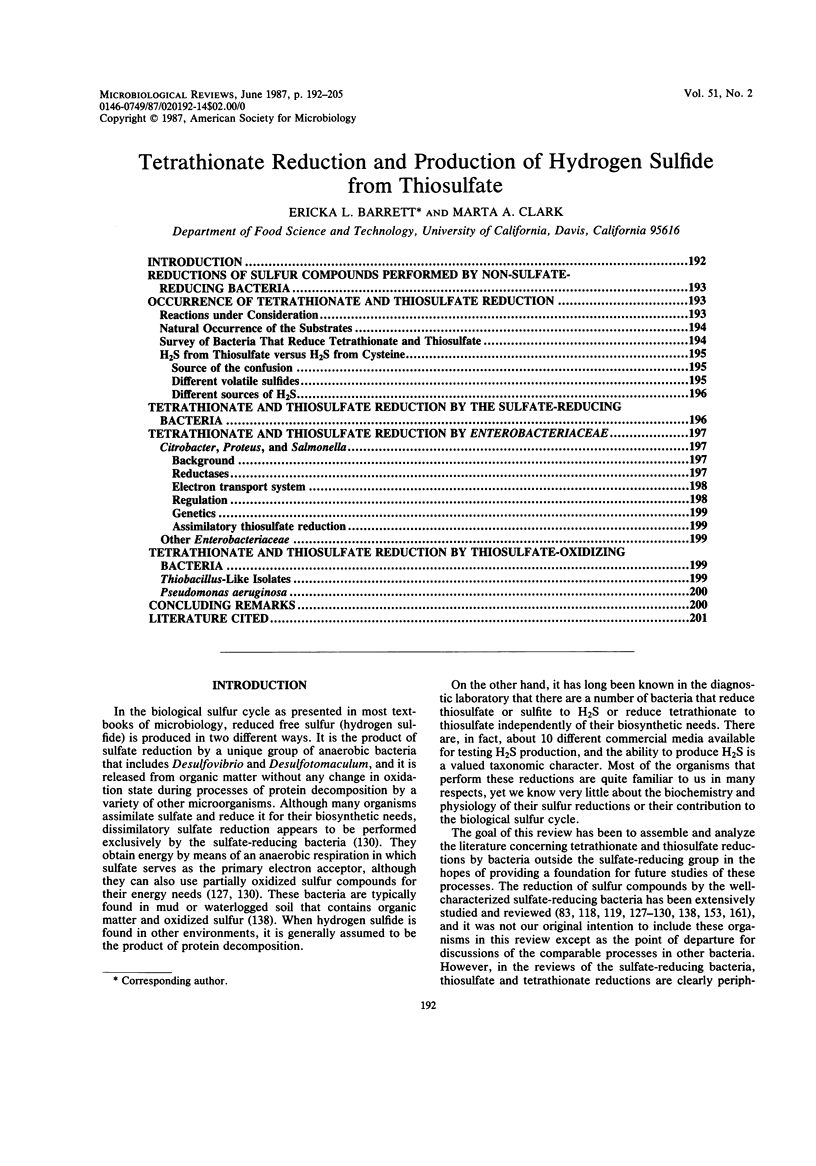
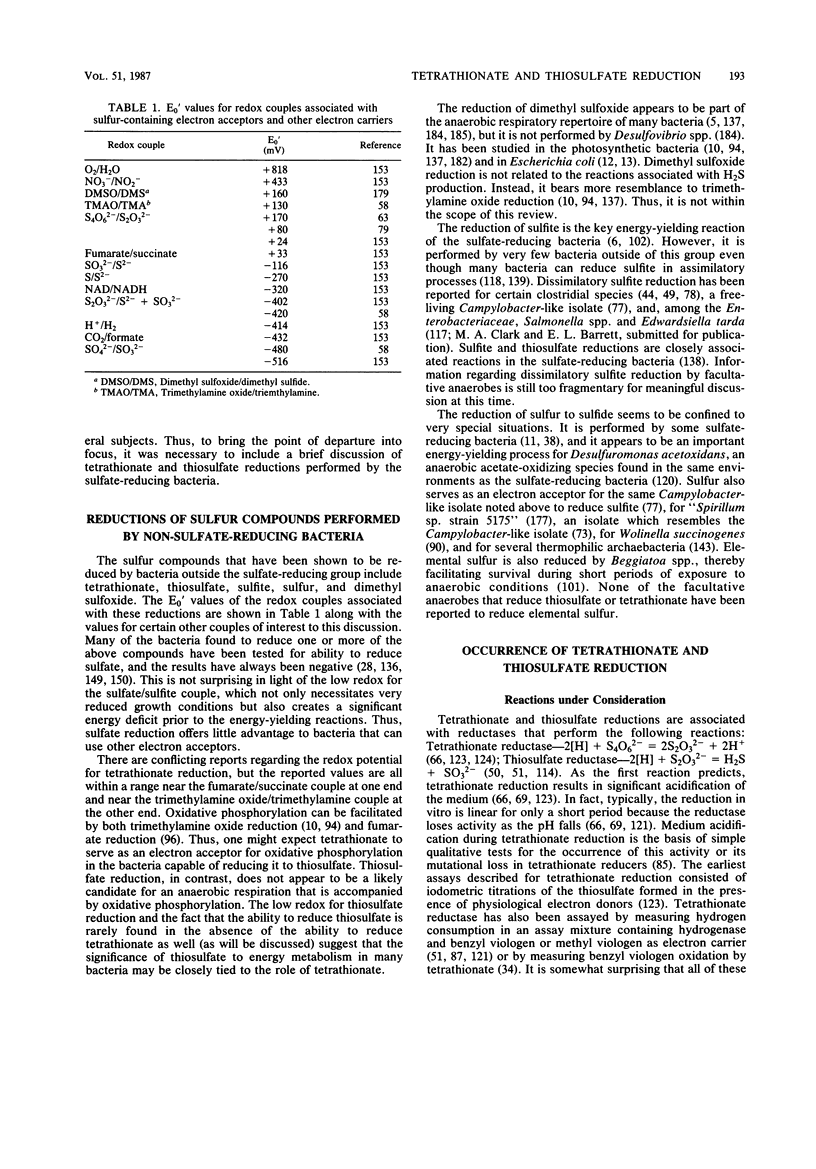
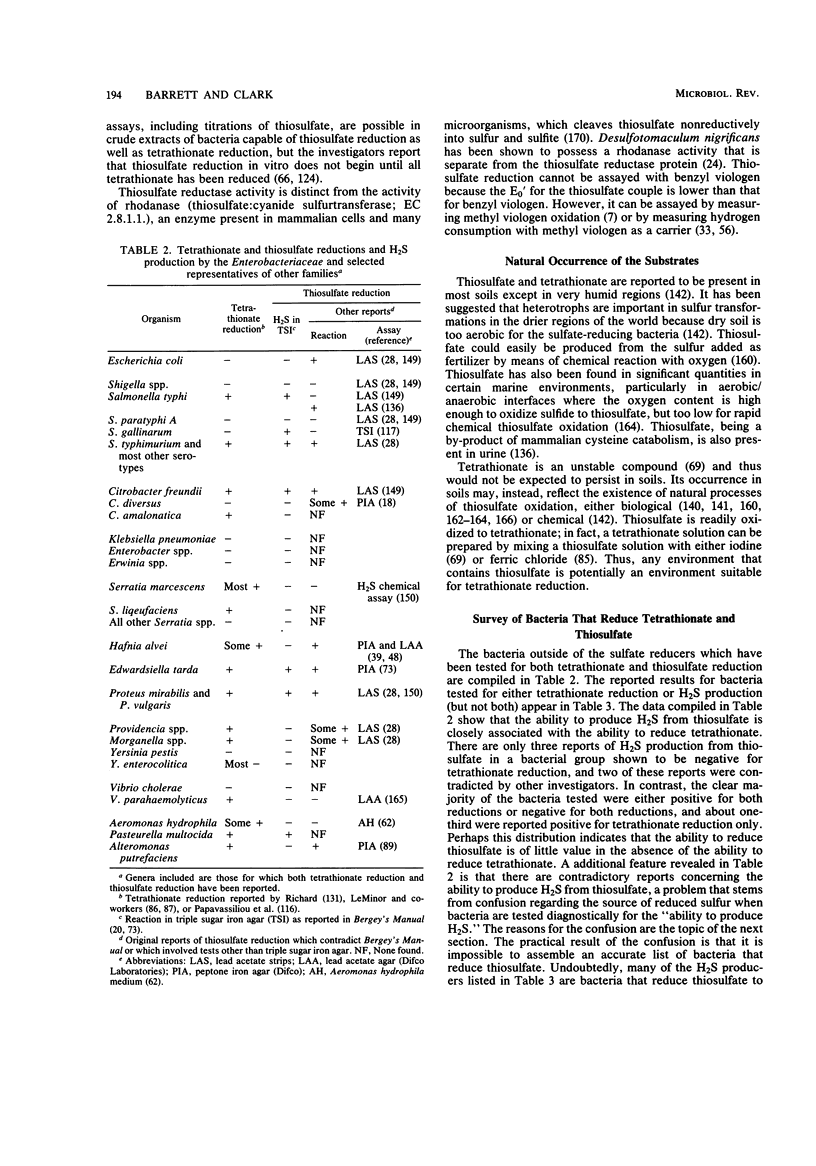
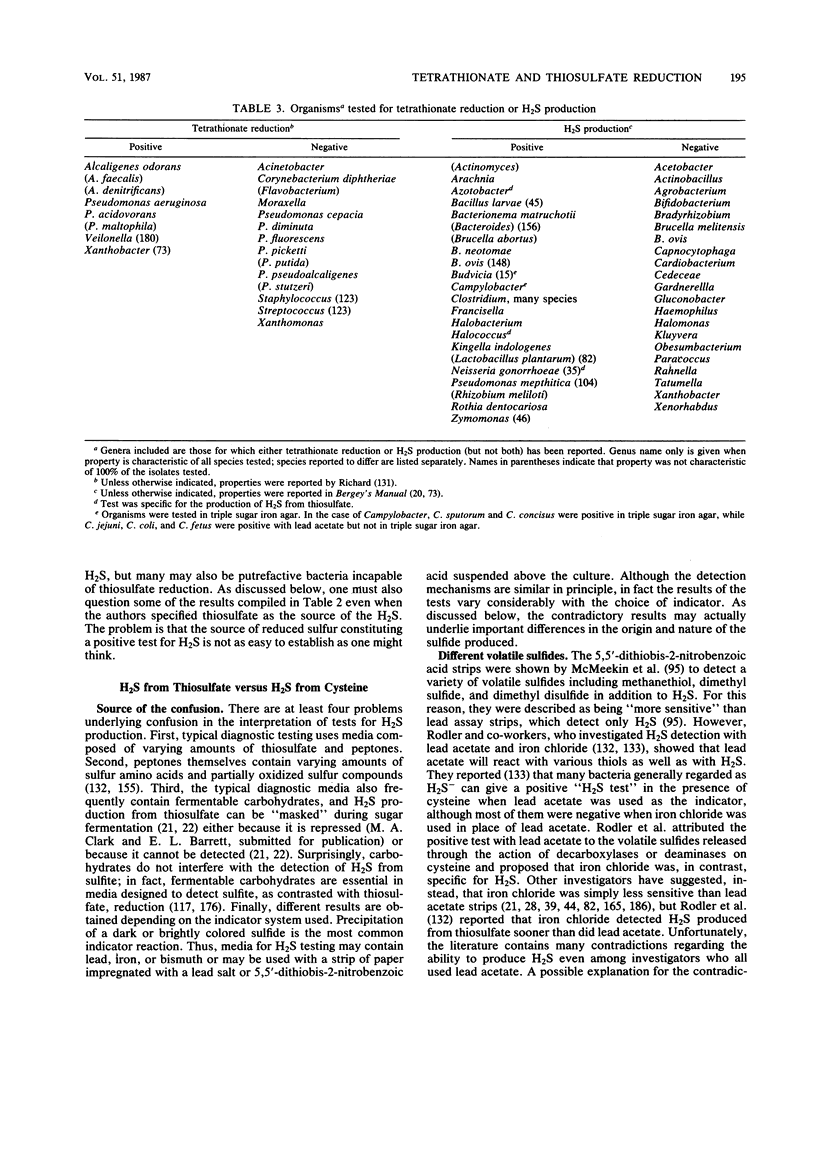
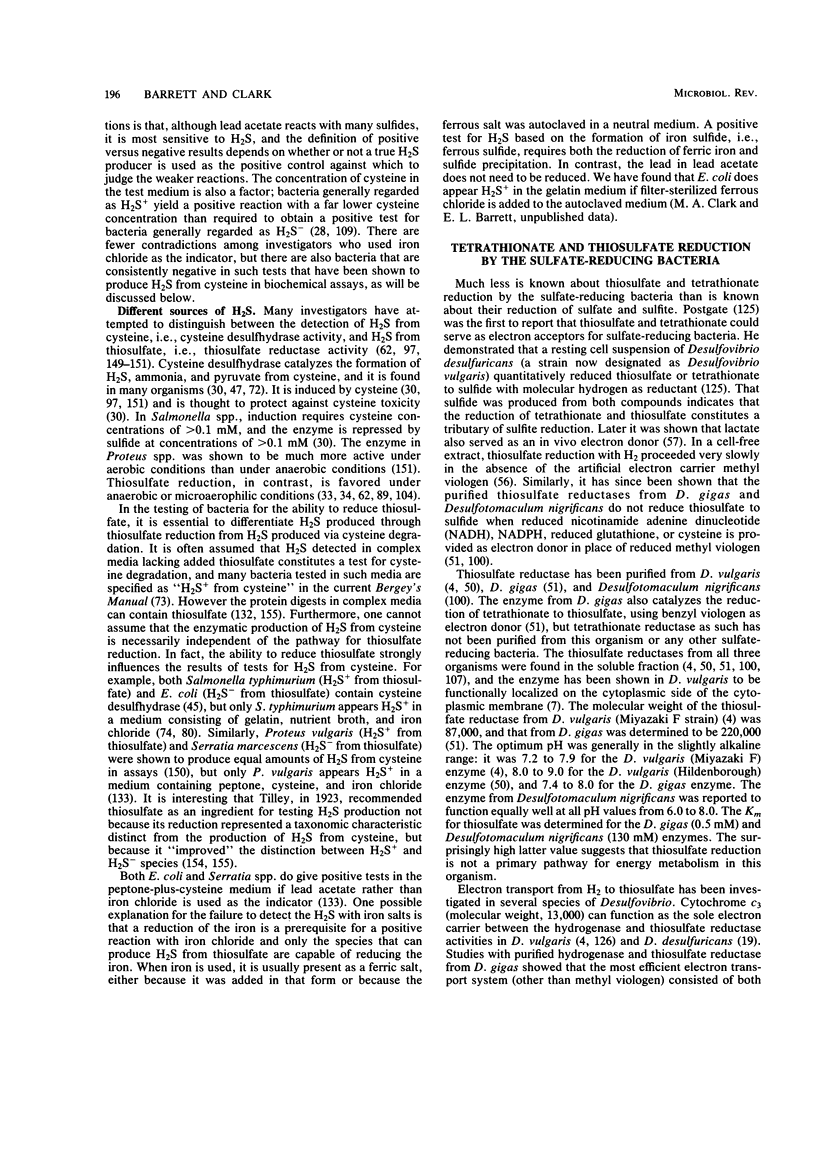
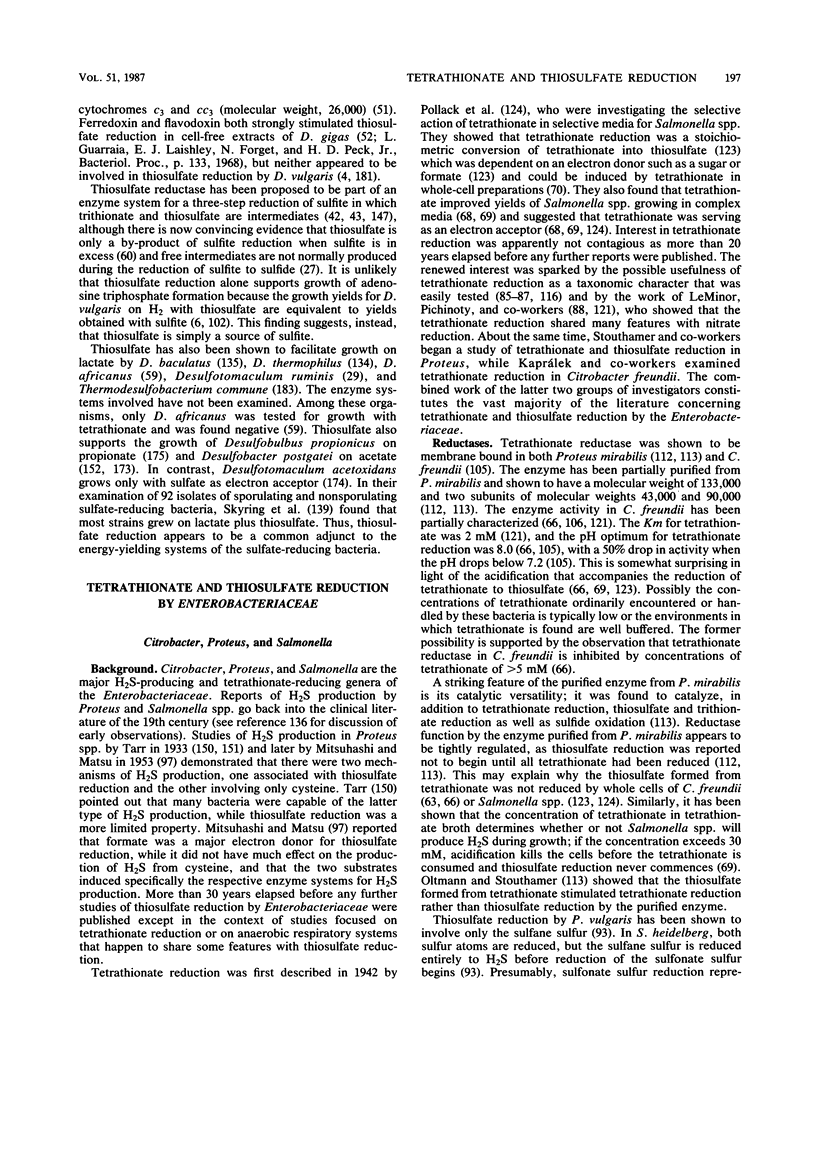
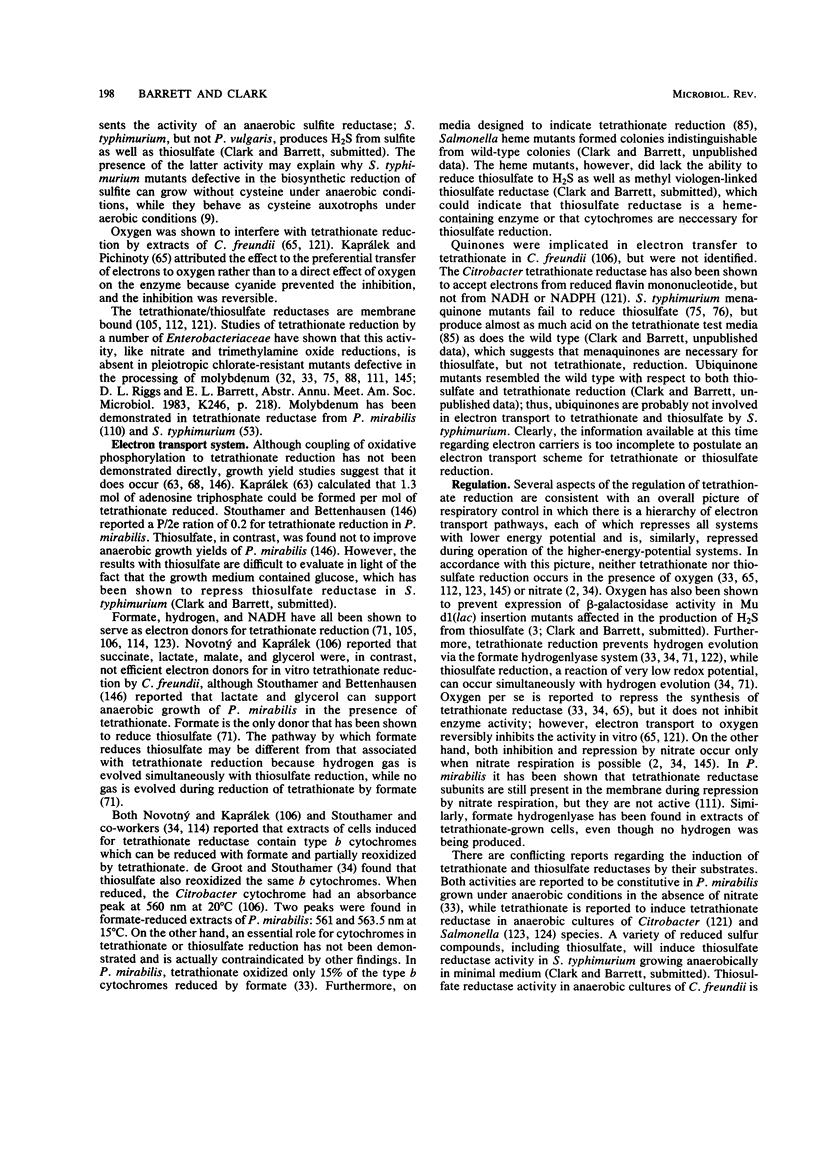
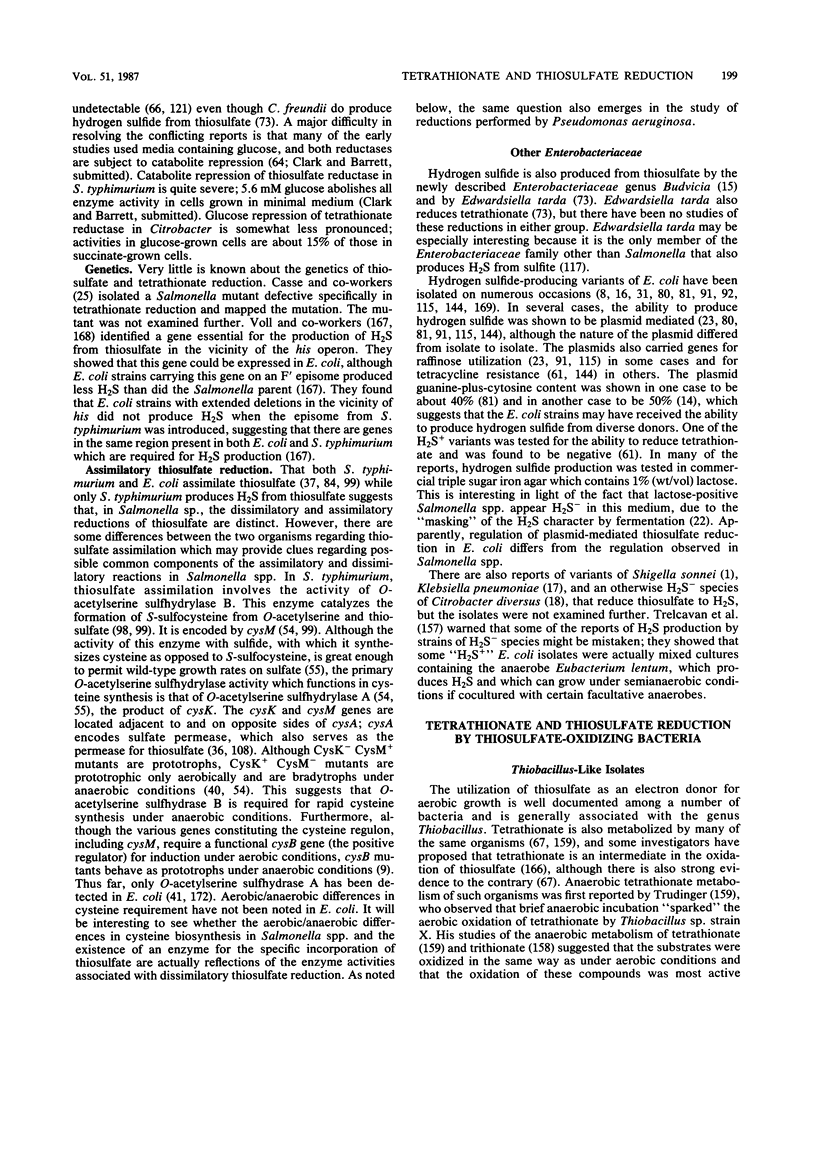
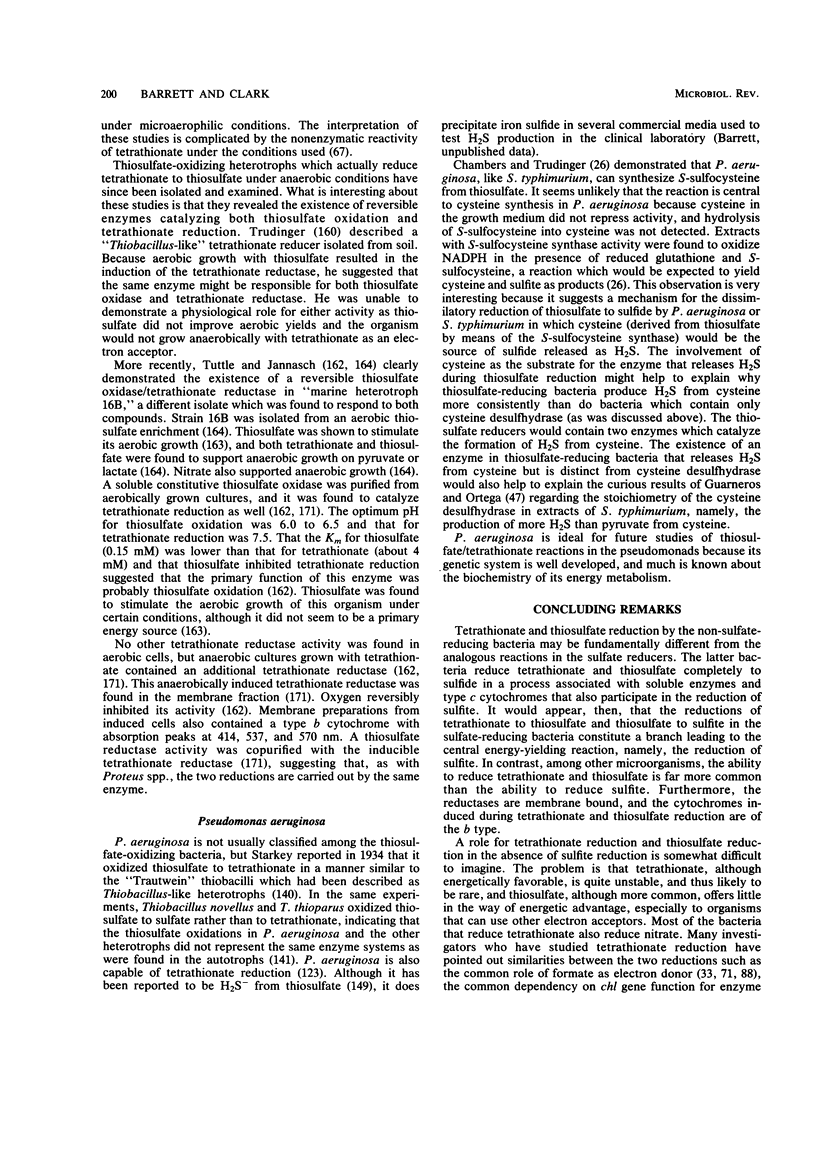
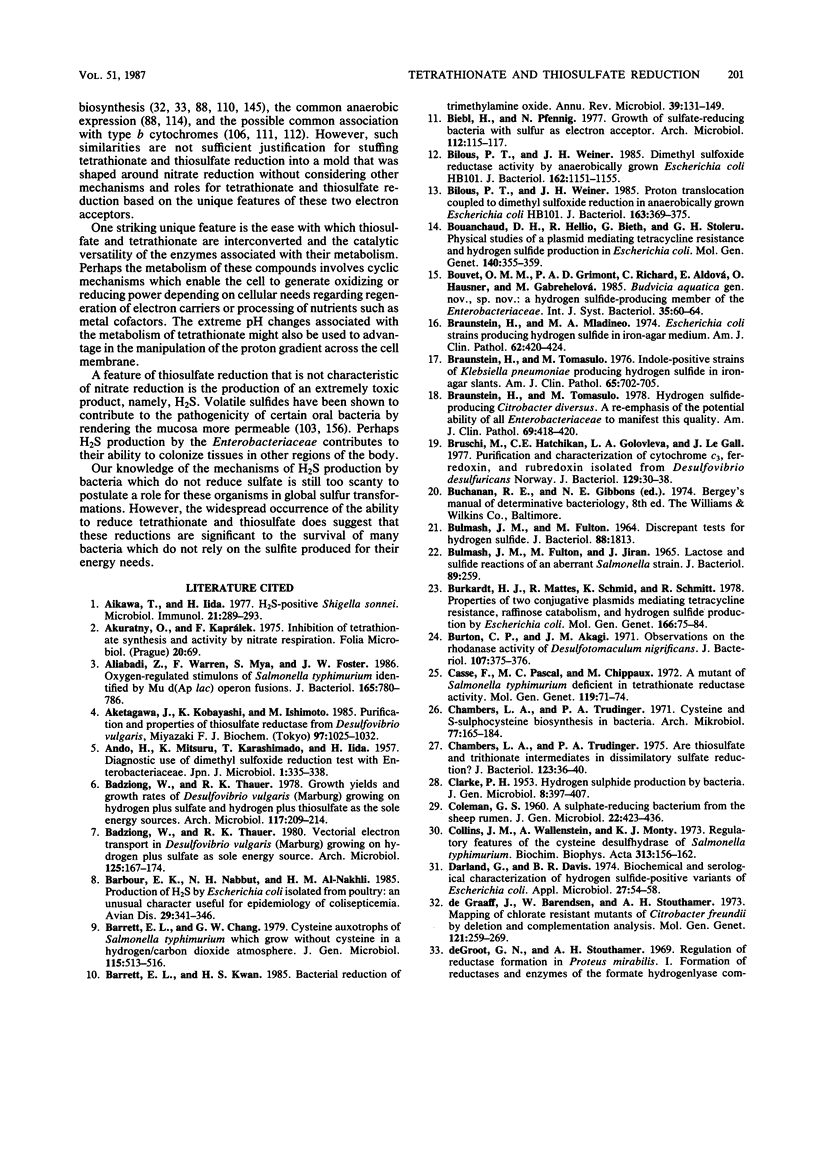
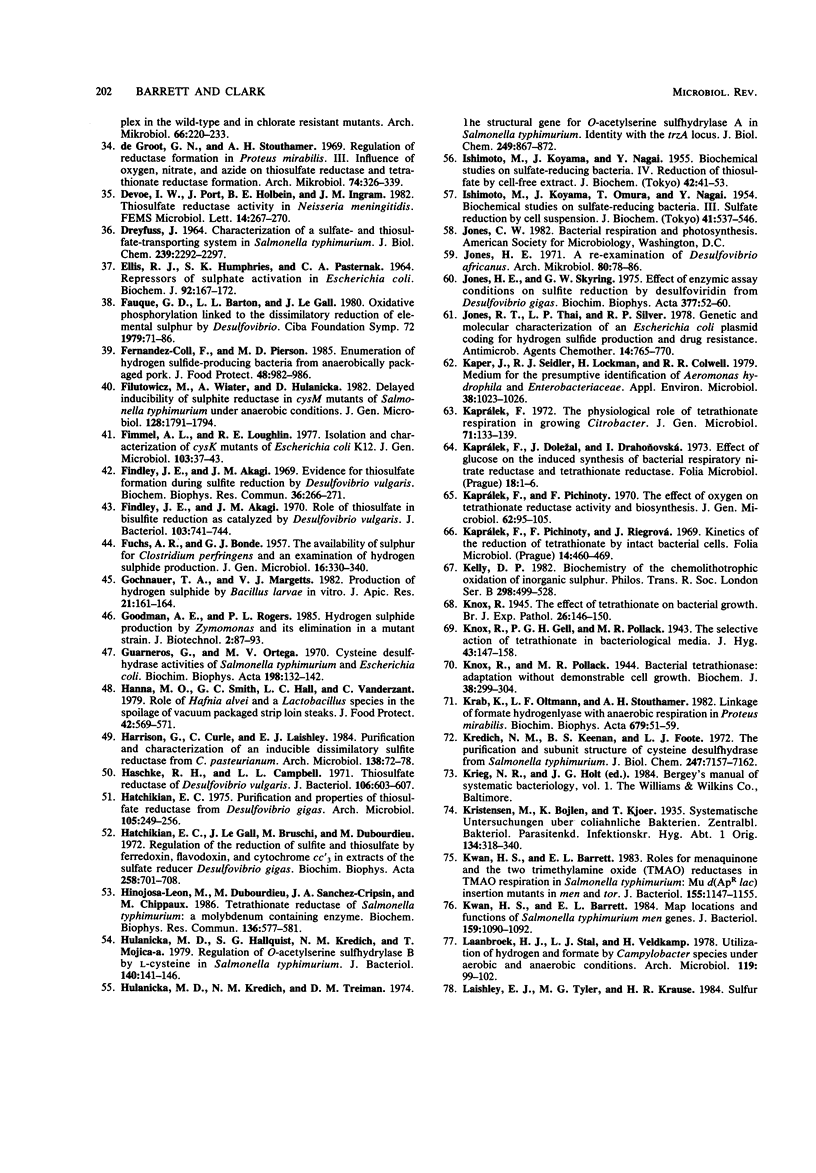

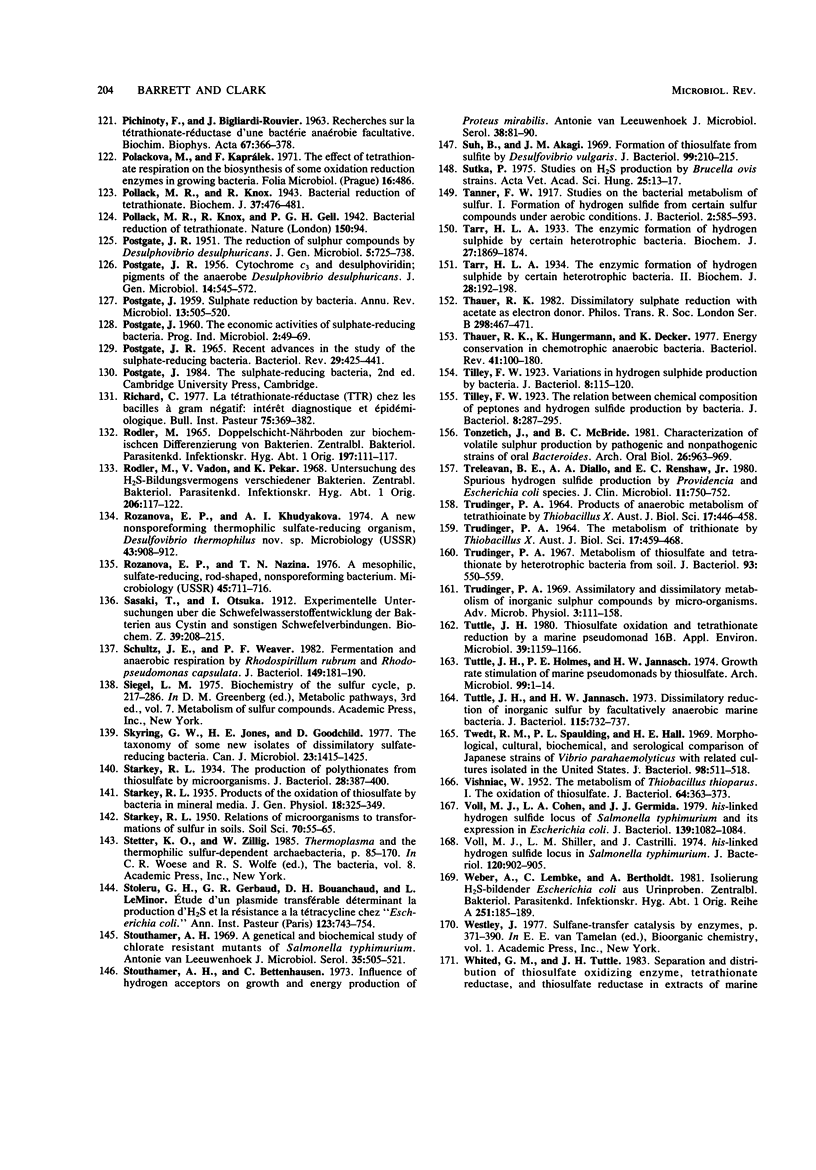
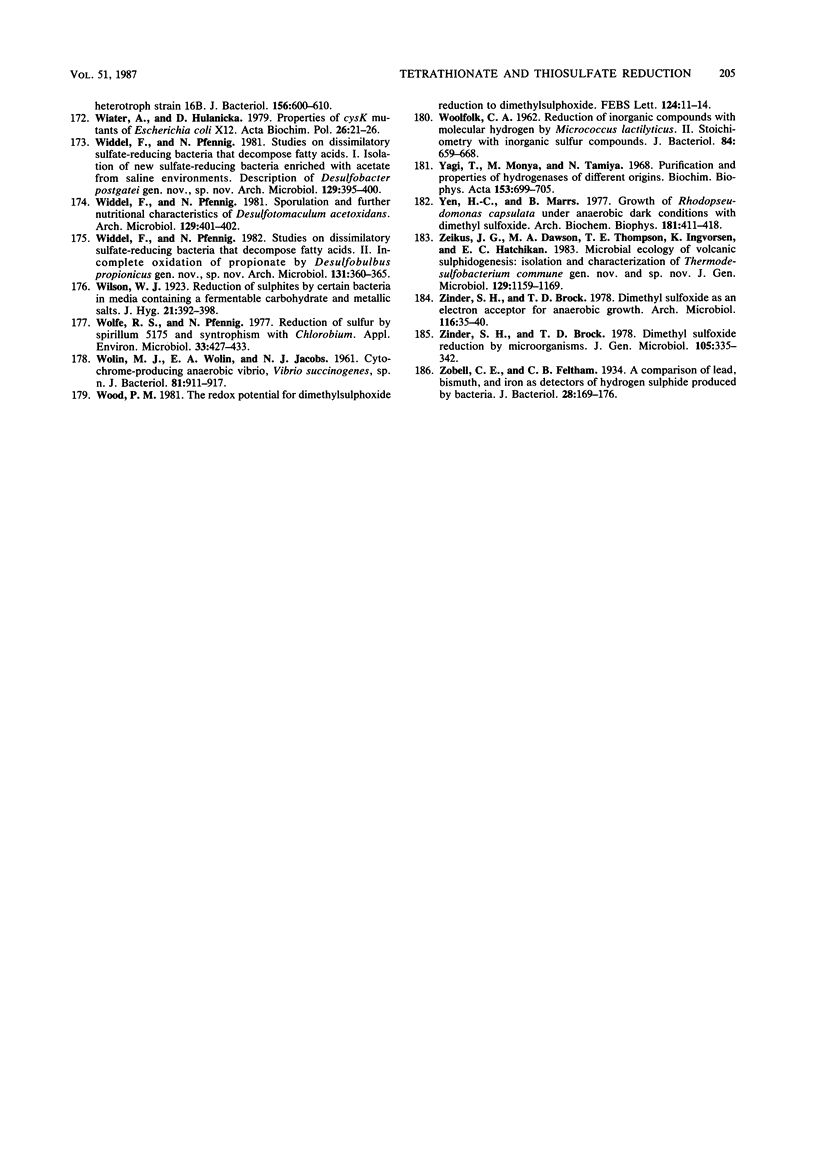
Selected References
These references are in PubMed. This may not be the complete list of references from this article.
- ANDO H., KUMAGAI M., KARASHIMADA T., IIDA H. Diagnostic use of dimethylsulfoxide reduction test within Enterobacteriaceae. Jpn J Microbiol. 1957 Oct;1(4):335–338. doi: 10.1111/j.1348-0421.1957.tb00032.x. [DOI] [PubMed] [Google Scholar]
- Aikawa T., Iida H. H2S-positive Shigella sonnei. Microbiol Immunol. 1977;21(5):289–293. doi: 10.1111/j.1348-0421.1977.tb00289.x. [DOI] [PubMed] [Google Scholar]
- Aketagawa J., Kobayashi K., Ishimoto M. Purification and properties of thiosulfate reductase from Desulfovibrio vulgaris, Miyazaki F. J Biochem. 1985 Apr;97(4):1025–1032. doi: 10.1093/oxfordjournals.jbchem.a135144. [DOI] [PubMed] [Google Scholar]
- Aliabadi Z., Warren F., Mya S., Foster J. W. Oxygen-regulated stimulons of Salmonella typhimurium identified by Mu d(Ap lac) operon fusions. J Bacteriol. 1986 Mar;165(3):780–786. doi: 10.1128/jb.165.3.780-786.1986. [DOI] [PMC free article] [PubMed] [Google Scholar]
- BULMASH J. M., FULTON M. DISCREPANT TESTS FOR HYDROGEN SULFIDE. J Bacteriol. 1964 Dec;88:1813–1813. doi: 10.1128/jb.88.6.1813-1813.1964. [DOI] [PMC free article] [PubMed] [Google Scholar]
- BULMASH J. M., FULTON M., JIRON J. LACTOSE AND SULFIDE REACTIONS OF AN ABERRANT SALMONELLA STRAIN. J Bacteriol. 1965 Jan;89:259–259. doi: 10.1128/jb.89.1.259-259.1965. [DOI] [PMC free article] [PubMed] [Google Scholar]
- Badziong W., Thauer R. K. Growth yields and growth rates of Desulfovibrio vulgaris (Marburg) growing on hydrogen plus sulfate and hydrogen plus thiosulfate as the sole energy sources. Arch Microbiol. 1978 May 30;117(2):209–214. doi: 10.1007/BF00402310. [DOI] [PubMed] [Google Scholar]
- Barbour E. K., Nabbut N. H., Al-Nakhli H. M. Production of H2S by Escherichia coli isolated from poultry: an unusual character useful for epidemiology of colisepticemia. Avian Dis. 1985 Apr-Jun;29(2):341–346. [PubMed] [Google Scholar]
- Barrett E. L., Chang G. W. Cysteine auxotrophs of Salmonella typhimurium which grow without cysteine in a hydrogen/carbon dioxide atmosphere. J Gen Microbiol. 1979 Dec;115(2):513–516. doi: 10.1099/00221287-115-2-513. [DOI] [PubMed] [Google Scholar]
- Barrett E. L., Kwan H. S. Bacterial reduction of trimethylamine oxide. Annu Rev Microbiol. 1985;39:131–149. doi: 10.1146/annurev.mi.39.100185.001023. [DOI] [PubMed] [Google Scholar]
- Biebl H., Pfennig Growth of sulfate-reducing bacteria with sulfur as electron acceptor. Arch Microbiol. 1977 Feb 4;112(1):115–117. doi: 10.1007/BF00446664. [DOI] [PubMed] [Google Scholar]
- Bilous P. T., Weiner J. H. Dimethyl sulfoxide reductase activity by anaerobically grown Escherichia coli HB101. J Bacteriol. 1985 Jun;162(3):1151–1155. doi: 10.1128/jb.162.3.1151-1155.1985. [DOI] [PMC free article] [PubMed] [Google Scholar]
- Bilous P. T., Weiner J. H. Proton translocation coupled to dimethyl sulfoxide reduction in anaerobically grown Escherichia coli HB101. J Bacteriol. 1985 Jul;163(1):369–375. doi: 10.1128/jb.163.1.369-375.1985. [DOI] [PMC free article] [PubMed] [Google Scholar]
- Braunstein H., Mladineo M. A. Escherichia coli strains producing hydrogen sulfide in iron-agar medium. Am J Clin Pathol. 1974 Sep;62(3):420–424. doi: 10.1093/ajcp/62.3.420. [DOI] [PubMed] [Google Scholar]
- Braunstein H., Tomasulo M. Hydrogen sulfide-producing Citrobacter diversus. A re-emphasis of the potential ability of all Enterobacteriaceae to manifest this quality. Am J Clin Pathol. 1978 Apr;69(4):418–420. doi: 10.1093/ajcp/69.4.418. [DOI] [PubMed] [Google Scholar]
- Braunstein H., Tomasulo M. Indole-positive strains of Klebsiella pneumoniae producing hydrogen sulfide in iron-agar slants. Am J Clin Pathol. 1976 May;65(5):702–705. doi: 10.1093/ajcp/65.5.702. [DOI] [PubMed] [Google Scholar]
- Bruschi M., Hatchikian C. E., Golovleva L. A., Gall J. L. Purification and characterization of cytochrome c3, ferredoxin, and rubredoxin isolated from Desulfovibrio desulfuricans Norway. J Bacteriol. 1977 Jan;129(1):30–38. doi: 10.1128/jb.129.1.30-38.1977. [DOI] [PMC free article] [PubMed] [Google Scholar]
- Burkardt H. J., Mattes R., Schmid K., Schmitt R. Properties of two conjugative plasmids mediating tetracycline resistance, raffinose catabolism and hydrogen sulfide production in Escherichia coli. Mol Gen Genet. 1978 Oct 25;166(1):75–84. doi: 10.1007/BF00379731. [DOI] [PubMed] [Google Scholar]
- Burton C. P., Akagi J. M. Observations on the rhodanese activity of Desulfotomaculum nigrificans. J Bacteriol. 1971 Jul;107(1):375–376. doi: 10.1128/jb.107.1.375-376.1971. [DOI] [PMC free article] [PubMed] [Google Scholar]
- CLARKE P. H. Hydrogen sulphide production by bacteria. J Gen Microbiol. 1953 Jun;8(3):397–407. doi: 10.1099/00221287-8-3-397. [DOI] [PubMed] [Google Scholar]
- COLEMAN G. S. A sulphate-reducing bacterium from the sheep rumen. J Gen Microbiol. 1960 Apr;22:423–436. doi: 10.1099/00221287-22-2-423. [DOI] [PubMed] [Google Scholar]
- Casse F., Pascal M. C., Chippaux M. A mutant of Salmonella typhimurium deficient in tetrathionate reductase activity. Mol Gen Genet. 1972;119(1):71–74. doi: 10.1007/BF00270446. [DOI] [PubMed] [Google Scholar]
- Chambers L. A., Trudinger P. A. Are thiosulfate and trithionate intermediates in dissimilatory sulfate reduction? J Bacteriol. 1975 Jul;123(1):36–40. doi: 10.1128/jb.123.1.36-40.1975. [DOI] [PMC free article] [PubMed] [Google Scholar]
- Chambers L. A., Trudinger P. A. Cysteine and S-sulphocysteine biosynthesis in bacteria. Arch Mikrobiol. 1971;77(2):165–184. doi: 10.1007/BF00408609. [DOI] [PubMed] [Google Scholar]
- Collins J. M., Wallenstein A., Monty K. J. Regulatory features of the cysteine desulfhydrase of Salmonella typhimurium. Biochim Biophys Acta. 1973 Jun 20;313(1):156–162. doi: 10.1016/0304-4165(73)90196-7. [DOI] [PubMed] [Google Scholar]
- DREYFUSS J. CHARACTERIZATION OF A SULFATE- AND THIOSULFATE-TRANSPORTING SYSTEM IN SALMONELLA TYPHIMURIUM. J Biol Chem. 1964 Jul;239:2292–2297. [PubMed] [Google Scholar]
- Darland G., Davis B. R. Biochemical and serological characterization of hydrogen sulfide-positive variants of Escherichia coli. Appl Microbiol. 1974 Jan;27(1):54–58. doi: 10.1128/am.27.1.54-58.1974. [DOI] [PMC free article] [PubMed] [Google Scholar]
- Ellis R. J., Humphries S. K., Pasternak C. A. Repressors of sulphate activation in Escherichia coli. Biochem J. 1964 Jul;92(1):167–172. doi: 10.1042/bj0920167. [DOI] [PMC free article] [PubMed] [Google Scholar]
- FUCHS A. R., BONDE G. J. The availability of sulphur for Clostridium perfringens and an examination of hydrogen sulphide production. J Gen Microbiol. 1957 Apr;16(2):330–340. doi: 10.1099/00221287-16-2-330. [DOI] [PubMed] [Google Scholar]
- Fauque G. D., Barton L. L., Le Gall J. Oxidative phosphorylation linked to the dissimilatory reduction of elemental sulphur by Desulfovibrio. Ciba Found Symp. 1979;(72):71–86. doi: 10.1002/9780470720554.ch5. [DOI] [PubMed] [Google Scholar]
- Filutowicz M., Wiater A., Hulanicka D. Delayed inducibility of sulphite reductase in cysM mutants of Salmonella typhimurium under anaerobic conditions. J Gen Microbiol. 1982 Aug;128(8):1791–1794. doi: 10.1099/00221287-128-8-1791. [DOI] [PubMed] [Google Scholar]
- Fimmel A. L., Loughlin R. E. Isolation and characterization of cysK mutants of Escherichia coli K12. J Gen Microbiol. 1977 Nov;103(1):37–43. doi: 10.1099/00221287-103-1-37. [DOI] [PubMed] [Google Scholar]
- Findley J. E., Akagi J. M. Evidence for thiosulfate formation during sulfite reduction by Desulfovibrio vulgaris. Biochem Biophys Res Commun. 1969 Jul 23;36(2):266–271. doi: 10.1016/0006-291x(69)90324-6. [DOI] [PubMed] [Google Scholar]
- Findley J. E., Akagi J. M. Role of thiosulfate in bisulfite reduction as catalyzed by Desulfovibrio vulgaris. J Bacteriol. 1970 Sep;103(3):741–744. doi: 10.1128/jb.103.3.741-744.1970. [DOI] [PMC free article] [PubMed] [Google Scholar]
- Guarneros G., Ortega M. V. Cysteine desulfhydrase activities of Salmonella typhimurium and Escherichia coli. Biochim Biophys Acta. 1970 Jan 14;198(1):132–142. doi: 10.1016/0005-2744(70)90041-0. [DOI] [PubMed] [Google Scholar]
- Harrison G., Curle C., Laishley E. J. Purification and characterization of an inducible dissimilatory type sulfite reductase from Clostridium pasteurianum. Arch Microbiol. 1984 May;138(1):72–78. doi: 10.1007/BF00425411. [DOI] [PubMed] [Google Scholar]
- Haschke R. H., Campbell L. L. Thiosulfate reductase of Desulfovibrio vulgaris. J Bacteriol. 1971 May;106(2):603–607. doi: 10.1128/jb.106.2.603-607.1971. [DOI] [PMC free article] [PubMed] [Google Scholar]
- Hatchikian E. C., Le Gall J., Bruschi M., Dubourdieu M. Regulation of the reduction of sulfite and thiosulfate by ferredoxin, flavodoxin and cytochrome cc' 3 in extracts of the sulfate reducer Desulfovibrio gigas. Biochim Biophys Acta. 1972 Mar 8;258(3):701–708. doi: 10.1016/0005-2744(72)90171-4. [DOI] [PubMed] [Google Scholar]
- Hatchikian E. C. Purification and properties of thiosulfate reductase from Desulfovibrio gigas. Arch Microbiol. 1975 Nov 7;105(3):249–256. doi: 10.1007/BF00447143. [DOI] [PubMed] [Google Scholar]
- Hinojosa-Leon M., Dubourdieu M., Sanchez-Crispin J. A., Chippaux M. Tetrathionate reductase of Salmonella thyphimurium: a molybdenum containing enzyme. Biochem Biophys Res Commun. 1986 Apr 29;136(2):577–581. doi: 10.1016/0006-291x(86)90479-1. [DOI] [PubMed] [Google Scholar]
- Hulanicka M. D., Hallquist S. G., Kredich N. M., Mojica-A T. Regulation of O-acetylserine sulfhydrylase B by L-cysteine in Salmonella typhimurium. J Bacteriol. 1979 Oct;140(1):141–146. doi: 10.1128/jb.140.1.141-146.1979. [DOI] [PMC free article] [PubMed] [Google Scholar]
- Hulanicka M. D., Kredich N. M., Treiman D. M. The structural gene for O-acetylserine sulfhydrylase A in Salmonella typhimurium. Identity with the trzA locus. J Biol Chem. 1974 Feb 10;249(3):867–872. [PubMed] [Google Scholar]
- Jones H. E. A re-examination of Desulfovibrio africanus. Arch Mikrobiol. 1971;80(1):78–86. doi: 10.1007/BF00410582. [DOI] [PubMed] [Google Scholar]
- Jones H. E., Skyring G. W. Effect of enzymic assay conditions on sulfite reduction catalysed by desulfoviridin from Desulfovibrio gigas. Biochim Biophys Acta. 1975 Jan 23;377(1):52–60. doi: 10.1016/0005-2744(75)90285-5. [DOI] [PubMed] [Google Scholar]
- Jones R. T., Thai L. P., Silver R. P. Genetic and molecular characterization of an Escherichia coli plasmid coding for hydrogen sulfide production and drug resistance. Antimicrob Agents Chemother. 1978 Nov;14(5):765–770. doi: 10.1128/aac.14.5.765. [DOI] [PMC free article] [PubMed] [Google Scholar]
- Kaper J., Seidler R. J., Lockman H., Colwell R. R. Medium for the presumptive identification of Aeromonas hydrophila and Enterobacteriaceae. Appl Environ Microbiol. 1979 Nov;38(5):1023–1026. doi: 10.1128/aem.38.5.1023-1026.1979. [DOI] [PMC free article] [PubMed] [Google Scholar]
- Kaprálek F., Pichinoty F. The effect of oxygen on tetrathionate reductase activity and biosynthesis. J Gen Microbiol. 1970 Jul;62(1):95–105. doi: 10.1099/00221287-62-1-95. [DOI] [PubMed] [Google Scholar]
- Kaprálek F. The physiological role of tetrathionate respiration in growing citrobacter. J Gen Microbiol. 1972 Jun;71(1):133–139. doi: 10.1099/00221287-71-1-133. [DOI] [PubMed] [Google Scholar]
- Kelly D. P. Biochemistry of the chemolithotrophic oxidation of inorganic sulphur. Philos Trans R Soc Lond B Biol Sci. 1982 Sep 13;298(1093):499–528. doi: 10.1098/rstb.1982.0094. [DOI] [PubMed] [Google Scholar]
- Knox R., Pollock M. R. Bacterial tetrathionase: adaptation without demonstrable cell growth: A report to the medical research council. Biochem J. 1944;38(4):299–304. doi: 10.1042/bj0380299. [DOI] [PMC free article] [PubMed] [Google Scholar]
- Kredich N. M., Keenan B. S., Foote L. J. The purification and subunit structure of cysteine desulfhydrase from Salmonella typhimurium. J Biol Chem. 1972 Nov 25;247(22):7157–7162. [PubMed] [Google Scholar]
- Kwan H. S., Barrett E. L. Map locations and functions of Salmonella typhimurium men genes. J Bacteriol. 1984 Sep;159(3):1090–1092. doi: 10.1128/jb.159.3.1090-1092.1984. [DOI] [PMC free article] [PubMed] [Google Scholar]
- Kwan H. S., Barrett E. L. Roles for menaquinone and the two trimethylamine oxide (TMAO) reductases in TMAO respiration in Salmonella typhimurium: Mu d(Apr lac) insertion mutations in men and tor. J Bacteriol. 1983 Sep;155(3):1147–1155. doi: 10.1128/jb.155.3.1147-1155.1983. [DOI] [PMC free article] [PubMed] [Google Scholar]
- LEINWEBER F. J., MONTY K. J. THE METABOLISM OF THIOSULFATE IN SALMONELLA TYPHIMURIUM. J Biol Chem. 1963 Nov;238:3775–3780. [PubMed] [Google Scholar]
- Laanbroek H. J., Stal L. H., Veldkamp H. Utilization of hydrogen and formate by Campylobacter spec. under aerobic and anaerobic conditions. Arch Microbiol. 1978 Oct 4;119(1):99–102. doi: 10.1007/BF00407935. [DOI] [PubMed] [Google Scholar]
- Laishley E. J., Tyler M. G., Krouse H. R. Sulfur isotope fractionation during SO3(2-) reduction by different clostridial species. Can J Microbiol. 1984 Jun;30(6):841–844. doi: 10.1139/m84-129. [DOI] [PubMed] [Google Scholar]
- Lautrop H., Orskov I., Gaarslev K. Hydrogensulphide producing variants of Escherichia coli. Acta Pathol Microbiol Scand B Microbiol Immunol. 1971;79(5):641–650. doi: 10.1111/j.1699-0463.1971.tb00092.x. [DOI] [PubMed] [Google Scholar]
- Layne P., Hu A. S., Balows A., Davis B. R. Extrachromosomal nature of hydrogen sulfide production in Escherichia coli. J Bacteriol. 1971 Jun;106(3):1029–1030. doi: 10.1128/jb.106.3.1029-1030.1971. [DOI] [PMC free article] [PubMed] [Google Scholar]
- Le Minor L., Chippaux M., Pichinoty F., Coynault C., Piéchaud M. Méthodes simples permettant de rechercher la tétrathionate-réductase en cultures liquides ou sur colonies isolées. Ann Inst Pasteur (Paris) 1970 Dec;119(6):733–737. [PubMed] [Google Scholar]
- Le Minor L. Distribution de la tétrathionate-réductase chez divers sérotypes de Salmonella. Ann Inst Pasteur (Paris) 1967 Jul;113(1):117–123. [PubMed] [Google Scholar]
- Le Minor L., Piéchaud M., Pichinoty F., Coynault C. Etude par transduction sur les nitrate-, tétrathionate- et thiosulfate-réductases de Salmonella typhi-murium. Ann Inst Pasteur (Paris) 1969 Nov;117(5):637–644. [PubMed] [Google Scholar]
- Levin R. E. Detection and incidence of specific species of spoilage bacteria on fish. I. Methodology. Appl Microbiol. 1968 Nov;16(11):1734–1737. doi: 10.1128/am.16.11.1734-1737.1968. [DOI] [PMC free article] [PubMed] [Google Scholar]
- Magalhães M., Véras A. Properties of pPE1572(Hys-Raf), a plasmid governing hydrogen sulphide production and raffinose fermentation in Escherichia coli. J Gen Microbiol. 1977 Apr;99(2):445–447. doi: 10.1099/00221287-99-2-445. [DOI] [PubMed] [Google Scholar]
- Maker M. D., Washington J. A., 2nd Hydrogen sulfide-producing variants of Escherichia coli. Appl Microbiol. 1974 Aug;28(2):303–305. doi: 10.1128/am.28.2.303-305.1974. [DOI] [PMC free article] [PubMed] [Google Scholar]
- McCready R. G., Grinenko V. A., Krouse H. R. Sulfur isotope fractionation by Proteus vulgaris and Salmonella heidelberg during the reduction of thiosulfate. Can J Microbiol. 1980 Oct;26(10):1173–1177. doi: 10.1139/m80-196. [DOI] [PubMed] [Google Scholar]
- McEwan A. G., Ferguson S. J., Jackson J. B. Electron flow to dimethylsulphoxide or trimethylamine-N-oxide generates a membrane potential in Rhodopseudomonas capsulata. Arch Microbiol. 1983 Dec;136(4):300–305. doi: 10.1007/BF00425221. [DOI] [PubMed] [Google Scholar]
- McMeekin T. A., Gibbs P. A., Patterson J. T. Detection of volatile sulfide-producing bacteria isolated from poultry-processing plants. Appl Environ Microbiol. 1978 Jun;35(6):1216–1218. doi: 10.1128/aem.35.6.1216-1218.1978. [DOI] [PMC free article] [PubMed] [Google Scholar]
- Miki K., Lin E. C. Anaerobic energy-yielding reaction associated with transhydrogenation from glycerol 3-phosphate to fumarate by an Escherichia coli system. J Bacteriol. 1975 Dec;124(3):1282–1287. doi: 10.1128/jb.124.3.1282-1287.1975. [DOI] [PMC free article] [PubMed] [Google Scholar]
- Nakamura T., Iwahashi H., Eguchi Y. Enzymatic proof for the identity of the S-sulfocysteine synthase and cysteine synthase B of Salmonella typhimurium. J Bacteriol. 1984 Jun;158(3):1122–1127. doi: 10.1128/jb.158.3.1122-1127.1984. [DOI] [PMC free article] [PubMed] [Google Scholar]
- Nakamura T., Kon Y., Iwahashi H., Eguchi Y. Evidence that thiosulfate assimilation by Salmonella typhimurium is catalyzed by cysteine synthase B. J Bacteriol. 1983 Nov;156(2):656–662. doi: 10.1128/jb.156.2.656-662.1983. [DOI] [PMC free article] [PubMed] [Google Scholar]
- Nakatsukasa W., Akagi J. M. Thiosulfate reductase isolated from Desulfotomaculum nigrificans. J Bacteriol. 1969 May;98(2):429–433. doi: 10.1128/jb.98.2.429-433.1969. [DOI] [PMC free article] [PubMed] [Google Scholar]
- Nelson D. C., Castenholz R. W. Use of reduced sulfur compounds by Beggiatoa sp. J Bacteriol. 1981 Jul;147(1):140–154. doi: 10.1128/jb.147.1.140-154.1981. [DOI] [PMC free article] [PubMed] [Google Scholar]
- Nicol D. J., Shaw M. K., Ledward D. A. Hydrogen sulfide production by bacteria and sulfmyoglobin formation in prepacked chilled beef. Appl Microbiol. 1970 Jun;19(6):937–939. doi: 10.1128/am.19.6.937-939.1970. [DOI] [PMC free article] [PubMed] [Google Scholar]
- Novotný C. Instability of the tetrathionate respiratory chain of Citrobacter freundii. Folia Microbiol (Praha) 1978;23(6):428–432. doi: 10.1007/BF02885570. [DOI] [PubMed] [Google Scholar]
- Novotný C., Kaprálek F. Participation of quinone and cytochrome b in tetrathionate reductase respiratory chain of Citrobacter freundii. Biochem J. 1979 Jan 15;178(1):237–240. doi: 10.1042/bj1780237. [DOI] [PMC free article] [PubMed] [Google Scholar]
- OLITZKI A. L. Hydrogen sulphide production by non-multiplying organisms and its inhibition by antibiotics. J Gen Microbiol. 1954 Oct;11(2):160–174. doi: 10.1099/00221287-11-2-160. [DOI] [PubMed] [Google Scholar]
- Odom J. M., Peck H. D., Jr Localization of dehydrogenases, reductases, and electron transfer components in the sulfate-reducing bacterium Desulfovibrio gigas. J Bacteriol. 1981 Jul;147(1):161–169. doi: 10.1128/jb.147.1.161-169.1981. [DOI] [PMC free article] [PubMed] [Google Scholar]
- Oltmann L. F., Claassen V. P., Kastelein P., Reijnders W. N., Stouthamer A. H. Influence of tungstate on the formation and activities of four reductases in Proteus mirabilis: identification of two new molybdo-enzymes: chlorate reductase and tetrathionate reductase. FEBS Lett. 1979 Oct 1;106(1):43–46. doi: 10.1016/0014-5793(79)80691-2. [DOI] [PubMed] [Google Scholar]
- Oltmann L. F., Reijnders W. N., Stouthamer A. H. The correlation between the protein composition of cytoplasmic membranes and the formation of nitrate reductase A, chlorate reductase C and tetrathionate reductase in Proteus mirabilis wild type and some cholate resistant mutants. Arch Microbiol. 1976 Dec 1;111(1-2):37–43. doi: 10.1007/BF00446547. [DOI] [PubMed] [Google Scholar]
- Oltmann L. F., Schoenmaker G. S., Stouthamer A. H. Solubilization and purification of a cytoplasmic membrane bound enzyme catalyzing tetrathionate and thiosulphate reduction in Proteus mirabilis. Arch Mikrobiol. 1974 Jun 7;98(1):19–30. doi: 10.1007/BF00425264. [DOI] [PubMed] [Google Scholar]
- Oltmann L. F., Stouthamer A. H. Reduction of tetrathionate, trithionate and thiosulphate, and oxidation of sulphide in proteus mirabilis. Arch Microbiol. 1975 Oct 27;105(2):135–142. doi: 10.1007/BF00447128. [DOI] [PubMed] [Google Scholar]
- Orskov I., Orskov F. Plasmid-determined H2S character in Escherichia coli and its relation to plasmid-carried raffinose fermentation and tetracycline resistance characters. Examination of 32 H2S-positive strains isolated during the years 1950 to 1971. J Gen Microbiol. 1973 Aug;77(2):487–499. doi: 10.1099/00221287-77-2-487. [DOI] [PubMed] [Google Scholar]
- Ota N., Galsworthy P. R., Pardee A. B. Genetics of sulfate transport by Salmonella typhimurium. J Bacteriol. 1971 Mar;105(3):1053–1062. doi: 10.1128/jb.105.3.1053-1062.1971. [DOI] [PMC free article] [PubMed] [Google Scholar]
- PECK H. D., Jr Symposium on metabolism of inorganic compounds. V. Comparative metabolism of inorganic sulfur compounds in microorganisms. Bacteriol Rev. 1962 Mar;26:67–94. doi: 10.1128/br.26.1.67-94.1962. [DOI] [PMC free article] [PubMed] [Google Scholar]
- PICHINOTY F., BIGLIARDI-ROUVIER J. [Research on tetrathionate reductase of a facultative anaerobic bacterium]. Biochim Biophys Acta. 1963 Mar 12;67:366–378. doi: 10.1016/0006-3002(63)91843-2. [DOI] [PubMed] [Google Scholar]
- POSTGATE J. R. Cytochrome c3 and desulphoviridin; pigments of the anaerobe Desulphovibrio desulphuricans. J Gen Microbiol. 1956 Jul;14(3):545–572. doi: 10.1099/00221287-14-3-545. [DOI] [PubMed] [Google Scholar]
- POSTGATE J. R. The reduction of sulphur compounds by Desulphovibrio desulphuricans. J Gen Microbiol. 1951 Oct;5(4):725–738. doi: 10.1099/00221287-5-4-725. [DOI] [PubMed] [Google Scholar]
- POSTGATE J. The economic activities of sulphate-reducing bacteria. Prog Ind Microbiol. 1960;2:47–69. [PubMed] [Google Scholar]
- Padron A. P., Dockstader W. B. Selective medium for hydrogen sulfide production by salmonellae. Appl Microbiol. 1972 Jun;23(6):1107–1112. doi: 10.1128/am.23.6.1107-1112.1972. [DOI] [PMC free article] [PubMed] [Google Scholar]
- Papavassiliou J., Samaraki-Lyberopoulou V., Piperakis G. Production of tetrathionate reductase by Salmonella. Can J Microbiol. 1969 Feb;15(2):238–240. doi: 10.1139/m69-041. [DOI] [PubMed] [Google Scholar]
- Peck H. D., Jr, LeGall J. Biochemistry of dissimilatory sulphate reduction. Philos Trans R Soc Lond B Biol Sci. 1982 Sep 13;298(1093):443–466. doi: 10.1098/rstb.1982.0091. [DOI] [PubMed] [Google Scholar]
- Pfennig N., Biebl H. Desulfuromonas acetoxidans gen. nov. and sp. nov., a new anaerobic, sulfur-reducing, acetate-oxidizing bacterium. Arch Microbiol. 1976 Oct 11;110(1):3–12. doi: 10.1007/BF00416962. [DOI] [PubMed] [Google Scholar]
- Pollock M. R., Knox R. Bacterial reduction of tetrathionate: A report to the medical research council. Biochem J. 1943 Oct;37(4):476–481. doi: 10.1042/bj0370476. [DOI] [PMC free article] [PubMed] [Google Scholar]
- Postgate J. R. Recent advances in the study of the sulfate-reducing bacteria. Bacteriol Rev. 1965 Dec;29(4):425–441. doi: 10.1128/br.29.4.425-441.1965. [DOI] [PMC free article] [PubMed] [Google Scholar]
- Rodler M. Doppelschicht-Nährboden zur biochemischen Differenzierung von Bakterien. 1. Enterobakterien. Zentralbl Bakteriol Orig. 1965 Jul;197(1):111–117. [PubMed] [Google Scholar]
- Rodler M., Vadon V., Pekár K. Untersuchung des H2S-Bildungsvermögens verschiedener Bakterien. Zentralbl Bakteriol Orig. 1968 Feb;206(1):117–122. [PubMed] [Google Scholar]
- Schultz J. E., Weaver P. F. Fermentation and anaerobic respiration by Rhodospirillum rubrum and Rhodopseudomonas capsulata. J Bacteriol. 1982 Jan;149(1):181–190. doi: 10.1128/jb.149.1.181-190.1982. [DOI] [PMC free article] [PubMed] [Google Scholar]
- Skyring G. W., Jones H. E., Goodchild D. The taxonomy of some new isolates of dissimilatory sulfate-reducing bacteria. Can J Microbiol. 1977 Oct;23(10):1415–1425. doi: 10.1139/m77-210. [DOI] [PubMed] [Google Scholar]
- Starkey R. L. The Production of Polythionates from Thiosulfate by Microörganisms. J Bacteriol. 1934 Oct;28(4):387–400. doi: 10.1128/jb.28.4.387-400.1934. [DOI] [PMC free article] [PubMed] [Google Scholar]
- Stouthamer A. H. A genetical and biochemical study of chlorate-resistant mutants of Salmonella typhimurium. Antonie Van Leeuwenhoek. 1969;35(4):505–521. doi: 10.1007/BF02219168. [DOI] [PubMed] [Google Scholar]
- Stouthamer A. H., Bettenhaussen C. Influence of hydrogen acceptors on growth and energy production of Proteus mirabilis. Antonie Van Leeuwenhoek. 1972;38(1):81–90. doi: 10.1007/BF02328079. [DOI] [PubMed] [Google Scholar]
- Suh B., Akagi J. M. Formation of thiosulfate from sulfite by Desulfovibrio vulgaris. J Bacteriol. 1969 Jul;99(1):210–215. doi: 10.1128/jb.99.1.210-215.1969. [DOI] [PMC free article] [PubMed] [Google Scholar]
- Sutka P. Studies on H2S production by Brucella ovis strains. Acta Vet Acad Sci Hung. 1975;25(1):13–17. [PubMed] [Google Scholar]
- Tanner F. W. Studies on the Bacterial Metabolism of Sulfur: I. Formation of Hydrogen Sulfide from Certain Sulfur Compounds Under Aerobic Conditions. J Bacteriol. 1917 Sep;2(5):585–593. doi: 10.1128/jb.2.5.585-593.1917. [DOI] [PMC free article] [PubMed] [Google Scholar]
- Tarr H. L. The enzymic formation of hydrogen sulphide by certain heterotrophic bacteria. II. Biochem J. 1934;28(1):192–198. doi: 10.1042/bj0280192. [DOI] [PMC free article] [PubMed] [Google Scholar]
- Tarr H. L. The enzymic formation of hydrogen sulphide by certain heterotrophic bacteria. Biochem J. 1933;27(6):1869–1874. doi: 10.1042/bj0271869. [DOI] [PMC free article] [PubMed] [Google Scholar]
- Thauer R. K. Dissimilatory sulphate reduction with acetate as electron donor. Philos Trans R Soc Lond B Biol Sci. 1982 Sep 13;298(1093):467–471. doi: 10.1098/rstb.1982.0092. [DOI] [PubMed] [Google Scholar]
- Thauer R. K., Jungermann K., Decker K. Energy conservation in chemotrophic anaerobic bacteria. Bacteriol Rev. 1977 Mar;41(1):100–180. doi: 10.1128/br.41.1.100-180.1977. [DOI] [PMC free article] [PubMed] [Google Scholar]
- Tilley F. W. The Relation Between Chemical Composition of Peptones and Hydrogen Sulphide Production by Bacteria. J Bacteriol. 1923 May;8(3):287–295. doi: 10.1128/jb.8.3.287-295.1923. [DOI] [PMC free article] [PubMed] [Google Scholar]
- Tilley F. W. Variations in Hydrogen Sulphide Production by Bacteria. J Bacteriol. 1923 Mar;8(2):115–120. doi: 10.1128/jb.8.2.115-120.1923. [DOI] [PMC free article] [PubMed] [Google Scholar]
- Tonzetich J., McBride B. C. Characterization of volatile sulphur production by pathogenic and non-pathogenic strains of oral Bacteroides. Arch Oral Biol. 1981;26(12):963–969. doi: 10.1016/0003-9969(81)90104-7. [DOI] [PubMed] [Google Scholar]
- Treleaven B. E., Diallo A. A., Renshaw E. C., Jr Spurious hydrogen sulfide production by Providencia and Escherichia coli species. J Clin Microbiol. 1980 Jun;11(6):750–752. doi: 10.1128/jcm.11.6.750-752.1980. [DOI] [PMC free article] [PubMed] [Google Scholar]
- Trudinger P. A. Metabolism of thiosulfate and tetrathionate by heterotrophic bacteria from soil. J Bacteriol. 1967 Feb;93(2):550–559. doi: 10.1128/jb.93.2.550-559.1967. [DOI] [PMC free article] [PubMed] [Google Scholar]
- Tuttle J. H., Holmes P. E., Jannasch H. W. Growth rate stimulation of marine pseudomonads by thiosulfate. Arch Microbiol. 1974;99(1):1–14. doi: 10.1007/BF00696218. [DOI] [PubMed] [Google Scholar]
- Tuttle J. H., Jannasch H. W. Dissimilatory reduction of inorganic sulfur by facultatively anaerobic marine bacteria. J Bacteriol. 1973 Sep;115(3):732–737. doi: 10.1128/jb.115.3.732-737.1973. [DOI] [PMC free article] [PubMed] [Google Scholar]
- Tuttle J. H. Thiosulfate Oxidation and Tetrathionate Reduction by Intact Cells of Marine Pseudomonad Strain 16B. Appl Environ Microbiol. 1980 Jun;39(6):1159–1166. doi: 10.1128/aem.39.6.1159-1166.1980. [DOI] [PMC free article] [PubMed] [Google Scholar]
- Twedt R. M., Spaulding P. L., Hall H. E. Morphological, cultural, biochemical, and serological comparison of Japanese strains of Vibrio parahemolyticus with related cultures isolated in the United States. J Bacteriol. 1969 May;98(2):511–518. doi: 10.1128/jb.98.2.511-518.1969. [DOI] [PMC free article] [PubMed] [Google Scholar]
- VISHNIAC W. The metabolism of Thiobacillus thioparus. I. The oxidation of thiosulfate. J Bacteriol. 1952 Sep;64(3):363–373. doi: 10.1128/jb.64.3.363-373.1952. [DOI] [PMC free article] [PubMed] [Google Scholar]
- Voll M. J., Cohen L. A., Germida J. J. his-Linked hydrogen sulfide locus of Salmonella typhimurium and its expression in Escherichia coli. J Bacteriol. 1979 Sep;139(3):1082–1084. doi: 10.1128/jb.139.3.1082-1084.1979. [DOI] [PMC free article] [PubMed] [Google Scholar]
- Voll M. J., Shiller L. M., Castrilli J. His-linked hydrogen sulfide locus in Salmonella typhimurium. J Bacteriol. 1974 Nov;120(2):902–905. doi: 10.1128/jb.120.2.902-905.1974. [DOI] [PMC free article] [PubMed] [Google Scholar]
- WOLIN M. J., WOLIN E. A., JACOBS N. J. Cytochrome-producing anaerobic Vibrio succinogenes, sp. n. J Bacteriol. 1961 Jun;81:911–917. doi: 10.1128/jb.81.6.911-917.1961. [DOI] [PMC free article] [PubMed] [Google Scholar]
- WOOLFOLK C. A. Reduction of inorganic compounds with molecular hydrogen by Micrococcus lactilyticus. II. Stoichiometry with inorganic sulfur compounds. J Bacteriol. 1962 Oct;84:659–668. doi: 10.1128/jb.84.4.659-668.1962. [DOI] [PMC free article] [PubMed] [Google Scholar]
- Weber A., Lembke C., Bertholdt A. Isolierung H2S-bildender Escherichia coli aus Urinproben. Zentralbl Bakteriol Mikrobiol Hyg A. 1981 Dec;251(2):185–189. [PubMed] [Google Scholar]
- Whited G. M., Tuttle J. H. Separation and distribution of thiosulfate-oxidizing enzyme, tetrathionate reductase, and thiosulfate reductase in extracts of marine heterotroph strain 16B. J Bacteriol. 1983 Nov;156(2):600–610. doi: 10.1128/jb.156.2.600-610.1983. [DOI] [PMC free article] [PubMed] [Google Scholar]
- Wiater A., Hulanicka D. Properties of cysK mutants of Escherichia coli K12. Acta Biochim Pol. 1979;26(1-2):21–28. [PubMed] [Google Scholar]
- Widdel F., Pfennig N. Sporulation and further nutritional characteristics of Desulfotomaculum acetoxidans. Arch Microbiol. 1981 Jul;129(5):401–402. doi: 10.1007/BF00406471. [DOI] [PubMed] [Google Scholar]
- Widdel F., Pfennig N. Studies on dissimilatory sulfate-reducing bacteria that decompose fatty acids. I. Isolation of new sulfate-reducing bacteria enriched with acetate from saline environments. Description of Desulfobacter postgatei gen. nov., sp. nov. Arch Microbiol. 1981 Jul;129(5):395–400. doi: 10.1007/BF00406470. [DOI] [PubMed] [Google Scholar]
- Wolfe R. S., Penning N. Reduction of sulfur by spirillum 5175 and syntrophism with Chlorobium. Appl Environ Microbiol. 1977 Feb;33(2):427–433. doi: 10.1128/aem.33.2.427-433.1977. [DOI] [PMC free article] [PubMed] [Google Scholar]
- Wood P. M. The redox potential for dimethyl sulphoxide reduction to dimethyl sulphide: evaluation and biochemical implications. FEBS Lett. 1981 Feb 9;124(1):11–14. doi: 10.1016/0014-5793(81)80042-7. [DOI] [PubMed] [Google Scholar]
- Yagi T., Honya M., Tamiya N. Purification and properties of hydrogenases of different origins. Biochim Biophys Acta. 1968 Apr 2;153(3):699–705. doi: 10.1016/0005-2728(68)90197-7. [DOI] [PubMed] [Google Scholar]
- Yen H. C., Marrs B. Growth of Rhodopseudomonas capsulata under anaerobic dark conditions with dimethyl sulfoxide. Arch Biochem Biophys. 1977 Jun;181(2):411–418. doi: 10.1016/0003-9861(77)90246-6. [DOI] [PubMed] [Google Scholar]
- Zinder S. H., Brock T. D. Dimethyl sulfoxide as an electron acceptor for anaerobic growth. Arch Microbiol. 1978 Jan 23;116(1):35–40. doi: 10.1007/BF00408731. [DOI] [PubMed] [Google Scholar]
- Zinder S. H., Brock T. D. Dimethyl sulphoxide reduction by micro-organisms. J Gen Microbiol. 1978 Apr;105(2):335–342. doi: 10.1099/00221287-105-2-335. [DOI] [PubMed] [Google Scholar]
- Zobell C. E., Feltham C. B. A Comparison of Lead, Bismuth, and Iron as Detectors of Hydrogen Sulphide Produced by Bacteria. J Bacteriol. 1934 Aug;28(2):169–176. doi: 10.1128/jb.28.2.169-176.1934. [DOI] [PMC free article] [PubMed] [Google Scholar]


